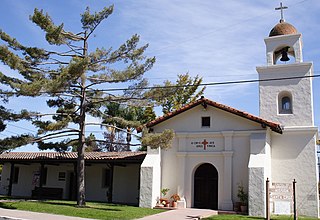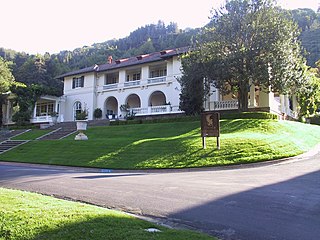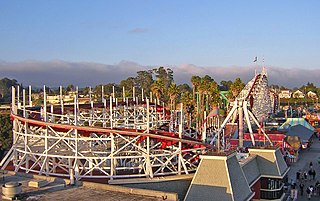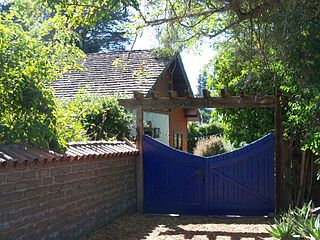
Mission Santa Cruz was a Spanish mission founded in 1791 by the Franciscan order in present-day Santa Cruz, California, dedicated by Father Fermín de Lasuén, second president of the Alta California missions. The mission was named for the feast of the Exaltation of the Cross, adopting the name given to a nearby creek by the missionary priest Juan Crespi, who accompanied the explorer Gaspar de Portolá when he camped on the banks of the San Lorenzo River on October 17, 1769.

Santa Cruz is the county seat and largest city of Santa Cruz County, in Northern California. As of the 2020 census, the city population was 62,956. Situated on the northern edge of Monterey Bay, Santa Cruz is a popular tourist destination, owing to its beaches, surf culture, and historic landmarks.

Branciforte, originally named Villa de Branciforte, was the last of only three secular pueblos founded by the Spanish colonial government of Alta California. The pueblo was established in 1797 on the eastern bluff of the San Lorenzo River, facing Mission Santa Cruz on the west side of the river, in modern-day Santa Cruz, California. The pueblo never prospered, and the area was annexed into the city of Santa Cruz, California in 1905.

The Montalvo Arts Center is a non-profit center for the arts in Saratoga, California, United States. Open to the public, Montalvo comprises a cultural and arts center, a park, hiking trails and the historic Villa Montalvo, an Italian Mediterranean Revival mansion nestled in the foothills of the Santa Cruz Mountains. The mansion and estate were constructed from 1912 to 1914 by California statesman and businessman James Duval Phelan. After Phelan's death, the entire estate was donated to California as a park and then a cultural and arts center as it exists today. The arts center maintains the estate in partnership with Santa Clara County. The mansion is a historic landmark, and in 1978 it was awarded inclusion in the National Register of Historic Places.

A California Historical Landmark (CHL) is a building, structure, site, or place in California that has been determined to have statewide historical landmark significance.

The Rancho San Andrés Castro Adobe is a historically and architecturally significant house located in the Pájaro Valley, California. The two-story Rancho San Andrés Castro Adobe is a historic rancho hacienda that was built between 1848-49.

The Giant Dipper is a historic wooden roller coaster located at the Santa Cruz Beach Boardwalk, an amusement park in Santa Cruz, California. The Giant Dipper, which replaced the Thompson's Scenic Railway, took 47 days to build and opened on May 17, 1924 at a cost of $50,000. With a height of 70 feet (21 m) and a speed of 55 miles per hour (89 km/h), it is one of the most popular wooden roller coasters in the world. As of 2012, over 60 million people have ridden the Giant Dipper since its opening. The ride has received several awards such as being named a National Historic Landmark, a Golden Age Coaster award, and a Coaster Landmark award.

The Dana–Thomas House is a home in Prairie School style designed by architect Frank Lloyd Wright. Built 1902–04 for patron Susan Lawrence Dana, it is located along East Lawrence Avenue in Springfield, Illinois. The home reflects the mutual affection of the patron and the architect for organic architecture, the relatively flat landscape of the U.S. state of Illinois, and the Japanese aesthetic as expressed in Japanese prints.

The Hinds House is a historic building in Santa Cruz, California. It was built in 1888 and 1889 by Alfred J. Hinds and his wife Sarah. Its Victorian style has been preserved and it is the largest surviving Stick-Eastlake house in Santa Cruz County. Today the Hinds House is a historical inn with rooms rented out to guests visiting or relocating to Santa Cruz.

The Branciforte Adobe, also known as the Craig-Lorenzana Adobe, is the only remaining dwelling from the Villa de Branciforte, the settlement that was established in 1797 at the time of the Mission Santa Cruz.

The Cowell Lime Works, in Santa Cruz, California, was a manufacturing complex that quarried limestone, produced lime and other limestone products, and manufactured wood barrels for transporting the finished lime. Part of its area is preserved as the Cowell Lime Works Historic District, which was listed on the National Register of Historic Places in 2007. In addition to the four lime kilns, cooperage and other features relating to lime manufacture, the Historic District also includes other structures associated with the Cowell Ranch, including barns, a blacksmith shop, ranch house, cook house and workers' cabins. The 32-acre Historic District is located within the University of California, Santa Cruz campus, to either side of the main campus entrance.

The Thomas Nast Home, also known as Villa Fontana, is a historic house on MacCulloch Avenue in Morristown, Morris County, New Jersey, United States. Built in 1860–61, it was the home of political cartoonist Thomas Nast (1840-1902) from 1871 until shortly before his death. Nast is best known for his caricatures, published in Harpers Weekly, in which he created or popularized now-iconic images, including typical American depictions of Santa Claus, the Democratic Donkey, and the Republican Elephant. The house was named a National Historic Landmark in 1964 and placed on the National Register of Historic Places in 1966.

Known informally as the Octagon Building, the redbrick octagonal building at 118 Cooper Street in Santa Cruz, California was built in 1882, adjacent to the first (1866) County Court House, to serve as the County Hall of Records. In 1894, a major fire destroyed most of the nearby buildings, including the adjacent courthouse, but the brick Octagon survived.

This is a list of the National Register of Historic Places listings in Santa Cruz County, California.

Villa Mira Monte is a historic villa in Morgan Hill, California, which is listed on the National Register of Historic Places. It was built for Hiram Morgan Hill, founder of Morgan Hill, and his wife Diana Murphy Hill, a Californio heiress.

The Superior Court of California, County of Santa Cruz, is the branch of the California superior court with jurisdiction over Santa Cruz County. It occupies two courthouses, one in Santa Cruz on Ocean Street and one in Watsonville on Second Street.

Thomas Theodore Tidball was an American pioneer who came out west during the time of the California gold rush. He was a veteran of the American Civil War who served as a captain in the Union Army. In 1866, Tidball settled in Jolon, California where he and George Dutton purchased the Antonio Ramirez adobe Inn in 1876 and converted it into a two-story hotel and stagecoach station. Tidball went on to establish his own General Store in 1890, which is now the only standing commercial building of Jolon. The Tidball Store is a landmark, which was listed on the National Register of Historic Places on December 12, 1976.

T.A. Oakes Building, is a historic commercial building in Carmel-by-the-Sea, California. It was built in 1922, by builder Thomas A. Oakes and designed by architect Thomas W. Morgan for a new Post Office and City Hall. It is an example of Western false front and Spanish Colonial Revival architecture styles. The building qualifies as an important building in the city's downtown historic district property survey and was recorded with the California Register of Historical Resources on October 28, 2002.




















